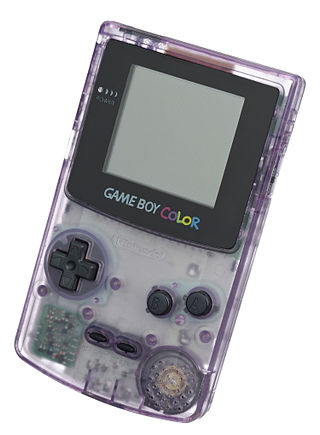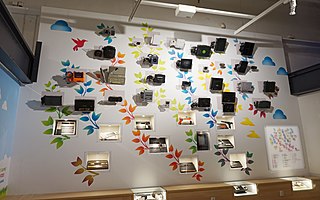
The Doctor V64 is a development and backup device made by Bung Enterprises Ltd that is used in conjunction with the Nintendo 64. The Doctor V64 also had the ability to play video CDs and audio CDs. Additionally, it could apply stereo 3D effects to the audio.

The Game Boy Color is an 8-bit handheld game console, manufactured by Nintendo, which was released in Japan on October 21, 1998 and to international markets that November. It is the successor to the Game Boy and is part of its product line. Critics like IGN consider it more akin to a hardware revision than a next generation product.

A handheld game console, or simply handheld console, is a small, portable self-contained video game console with a built-in screen, game controls and speakers. Handheld game consoles are smaller than home video game consoles and contain the console, screen, speakers, and controls in one unit, allowing people to carry them and play them at any time or place.

The Neo Geo Pocket (NGP) is a monochrome handheld game console released by SNK. It was the company's first handheld system and is part of the Neo Geo family. It debuted in Japan in late 1998 but never saw a western release, being exclusive to Japan and Hong Kong.

The WonderSwan is a handheld game console released in Japan by Bandai. It was developed by Gunpei Yokoi's company Koto Laboratory and Bandai, and was the last piece of hardware Yokoi developed before his death in 1997. Released in 1999 in the sixth generation of video game consoles, the WonderSwan and its two later models, the WonderSwan Color and SwanCrystal were officially supported until being discontinued by Bandai in 2003. During its lifespan, no variation of the WonderSwan was released outside of Japan.

SNK Corporation is a Japanese video game hardware and software company. It is the successor to the company Shin Nihon Kikaku and presently owns the SNK video game brand and the Neo Geo video game platform, and electronics. SNK's predecessor Shin Nihon Kikaku Corporation was founded in 1978 by Eikichi Kawasaki. In 1981, the name was informally shortened to SNK Corporation, which became the company's official name in 1986.

The Neo Geo Pocket Color (NGPC) is a 16-bit color handheld game console developed and manufactured by SNK. It is a successor to SNK's monochrome Neo Geo Pocket handheld which was released in 1998 in Japan, with the Color being fully backward compatible. The Neo Geo Pocket Color was released on March 19, 1999 in Japan, August 6, 1999 in North America, and October 1, 1999 in Europe, entering markets all dominated by Nintendo, competing with Nintendo's Game Boy Color.

A home video game console is a video game console that is designed to be connected to a display device, such as a television, and an external power source as to play video games. Home consoles are generally less powerful and customizable than personal computers, designed to have advanced graphics abilities but limited memory and storage space to keep the units affordable. While initial consoles were dedicated units with only a few games fixed into the electronic circuits of the system, most consoles since support the use of swappable game media, either through game cartridges, optical discs, or through digital distribution to internal storage.

Lik Sang was a popular distributor of Asian electronics. The company sold import games, toys, figures, anime-related items, and obscure adapters and controllers for various video game platforms. Lik Sang closed as of October 24, 2006, as a result of multiple lawsuits filed against them by Sony.
1994 saw many sequels and prequels in video games, such as Super Metroid, Donkey Kong Country, Final Fantasy VI, Sonic 3 & Knuckles, Super Street Fighter II Turbo and Virtua Fighter 2 and Doom II, along with new titles such as Daytona USA, Ace Driver, Alpine Racer and Tekken.
Homebrew, when applied to video games, refers to software produced by hobbyists for proprietary video game consoles which are not intended to be user-programmable. The official documentation is often only available to licensed developers, and these systems may use storage formats that make distribution difficult, such as ROM cartridges or encrypted CD-ROMs. Many consoles have hardware restrictions to prevent unauthorized development.
A video game accessory is a distinct piece of hardware that is required to use a video game console, or one that enriches the video game's play experience. Essentially, video game accessories are everything except the console itself, such as controllers, memory, power adapters (AC), and audio/visual cables. Most video game consoles come with the accessories required to play games out of the box : one A/V cable, one AC cable, and a controller. Memory is usually the most required accessory outside of these, as game data cannot be saved to compact discs. The companies that manufacture video game consoles also make these accessories for replacement purposes as well as improving the overall experience. There is an entire industry of companies that create accessories for consoles as well, called third-party companies. The prices are often lower than those made by the maker of the console (first-party). This is usually achieved by avoiding licensing or using cheaper materials. For the mobile systems like the PlayStation Portable and Game Boy iterations, there are many accessories to make them more usable in mobile environments, such as mobile chargers, lighting to improve visibility, and cases to both protect and help organize the collection of system peripherals to. Newer accessories include many home-made things like mod chips to bypass manufacturing protection or homemade software.
Import gamers are a subset of the video game player community that take part in the practice of playing video games from another region, usually from Japan where the majority of games for certain systems originate.

Neo Geo is a family of video game hardware that was developed by SNK. On the market from 1990 to 2004, the brand originated with the release of an arcade system, the Neo Geo Multi Video System (MVS) and its home console counterpart, the Neo Geo Advanced Entertainment System (AES).
Playasia is an online retailer of entertainment products from Asia. The website sells import games, DVDs, music, CDs, gadgets, groceries, books, gaming console accessories, cables and toys. Playasia is based in Hong Kong and caters to the Asia-Pacific region, but also offers most of the products to international buyers.
Tototek is a Hong Kong-based company that develops video game accessories, with a big focus on older consoles. Among their products are flash cartridges for the Master System, PC Engine, Mega Drive, and Super Nintendo Entertainment System. They have converters which make it possible to use PlayStation joypads on other systems. Also available are backup units, which make it possible to transfer cartridge data onto computers.
Nintendo 64 accessories are first-party Nintendo hardware—and third-party hardware, licensed and unlicensed. Nintendo's first-party accessories are mainly transformative system expansions: the 64DD Internet multimedia platform, with a floppy drive, video capture and editor, game building setup, web browser, and online service; the controller plus its own expansions for storage and rumble feedback; and the RAM-boosting Expansion Pak for big improvements in graphics and gameplay. Third-party accessories include the essential game developer tools built by SGI and SN Systems on Nintendo's behalf, an unlicensed SharkWire online service, and unlicensed cheaper counterparts to first-party items. In the fifth generation of video game consoles, the Nintendo 64 had a market lifespan from 1996 to 2002.

A game backup device, informally called a copier, is a device for backing up ROM data from a video game cartridge to a computer file called a ROM image and playing them back on the official hardware. Recently flash cartridges, especially on the Game Boy Advance and Nintendo DS platforms, only support the latter function; they cannot be used for backing up ROM data. Game backup devices also make it possible to develop homebrew software on video game systems. Game backup devices differ from modchips in that modchips are used in conjunction with systems that use generally available media such as CDs and DVDs, whereas game backup devices are used with systems that use cartridges.












